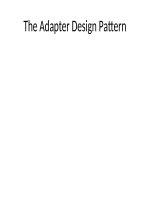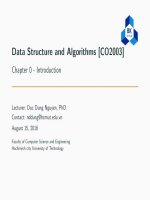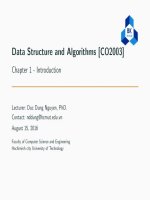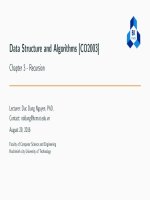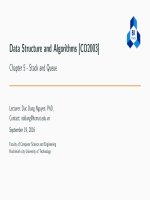C++ programming program design including data structure 7th ch21
Bạn đang xem bản rút gọn của tài liệu. Xem và tải ngay bản đầy đủ của tài liệu tại đây (991.54 KB, 76 trang )
Chapter 21:
Standard Template Library (STL)
Objectives
• In this chapter, you will:
– Learn about the Standard Template Library (STL)
– Become familiar with the three basic components of
the STL: containers, iterators, and algorithms
– Become familiar with basic operations on vector
objects
– Learn about the member functions common to all
containers
– Learn about the member functions common to all
sequence containers
C++ Programming: Program Design Including Data Structures, Seventh Edition
2
Objectives (cont’d.)
– Learn how to use the copy algorithm
– Explore how to use range-based for loops
– Explore how various containers, such as deque and list,
are used to manipulate data in a program
– Learn about various types of iterators and how they are
used
– Explore how to use the associative containers sets,
multisets, maps and multimaps
C++ Programming: Program Design Including Data Structures, Seventh Edition
3
Objectives (cont’d.)
– Explore how to use the container adapters stacks and
queues
– Become familiar with the various types of STL
algorithms
– Learn about function objects: arithmetic and relational
– Become familiar with insert iterators
– Explore how to use various generic algorithms
C++ Programming: Program Design Including Data Structures, Seventh Edition
4
Introduction
• ANSI/ISO Standard C++ is equipped with a Standard
Template Library (STL)
• STL includes class templates to process lists, stacks,
and queues
• This chapter:
– Discusses many important features of the STL
– Shows how to use its tools
C++ Programming: Program Design Including Data Structures, Seventh Edition
5
Components of the STL
• Components of the STL:
– Containers
– Iterators
– Algorithms
• Containers and iterators: class templates
• Iterators: used to step through the elements of a
container
• Algorithms: used to manipulate data
C++ Programming: Program Design Including Data Structures, Seventh Edition
6
Container Types
• Manage objects of a given type
• Three categories:
– Sequence (sequential) containers
– Associative containers
– Container adapters
C++ Programming: Program Design Including Data Structures, Seventh Edition
7
Sequence Containers
• Sequence container: every object in the container
has a specific position
• Three predefined sequence containers:
– vector
– deque
– list
C++ Programming: Program Design Including Data Structures, Seventh Edition
8
Sequence Container: vector
• Stores and manages its objects in a dynamic array
• Must use: #include <vector>
• To define an object of type vector, specify the type
of the object
– Examples:
vector<int> intList;
vector<string> stringList;
• vector contains several constructors
C++ Programming: Program Design Including Data Structures, Seventh Edition
9
Sequence Container: vector
(cont’d.)
C++ Programming: Program Design Including Data Structures, Seventh Edition
10
Sequence Container: vector
(cont’d.)
• Basic vector operations:
– Item insertion
– Item deletion
– Stepping through the elements
• Vector elements can be processed just as they can in
an array
C++ Programming: Program Design Including Data Structures, Seventh Edition
11
Sequence Container: vector
(cont’d.)
C++ Programming: Program Design Including Data Structures, Seventh Edition
12
Sequence Container: vector
(cont’d.)
C++ Programming: Program Design Including Data Structures, Seventh Edition
13
Sequence Container: vector
(cont’d.)
C++ Programming: Program Design Including Data Structures, Seventh Edition
14
Declaring an Iterator to a
Vector Container
• A vector contains a typedef iterator
• Examples:
vector<int>::iterator intVecIter;
– Declares intVecIter to be an iterator into a vector
container of type int
++intVecIter
– Advances the iterator
*intVecIter
– Returns element at current iterator position
C++ Programming: Program Design Including Data Structures, Seventh Edition
15
Containers and the
Functions begin and end
• Every container contains member functions:
– begin: returns the position of the first element
– end: returns the position of the last element
• Both functions have no parameters
C++ Programming: Program Design Including Data Structures, Seventh Edition
16
Member Functions Common to All
Containers
C++ Programming: Program Design Including Data Structures, Seventh Edition
17
Member Functions Common to All
Containers (cont’d.)
C++ Programming: Program Design Including Data Structures, Seventh Edition
18
Member Functions Common to All
Containers (cont’d.)
C++ Programming: Program Design Including Data Structures, Seventh Edition
19
Member Functions Common to
Sequence Containers
C++ Programming: Program Design Including Data Structures, Seventh Edition
20
Member Functions Common to
Sequence Containers (cont’d.)
C++ Programming: Program Design Including Data Structures, Seventh Edition
21
The copy Algorithm
• Function copy: convenient way to output the
elements of a container
• Copies elements from one place to another
– Can output the elements of a vector
• Prototype:
– Copies elements within range first1...last-1
• Must use: #include <algorithm>
C++ Programming: Program Design Including Data Structures, Seventh Edition
22
The ostream Iterator and the Function
copy
• copy can output a container using an iterator
– Iterator of type ostream specifies destination
• When creating an iterator of type ostream:
– Specify the type of element that the iterator will output
C++ Programming: Program Design Including Data Structures, Seventh Edition
23
Sequence Container: deque
• deque: double-ended queue
– Implemented as dynamic arrays
• A deque can expand in either direction
– Elements can be inserted at both ends and in the middle
• Must use #include <deque>
• class deque has several constructors
C++ Programming: Program Design Including Data Structures, Seventh Edition
24
Sequence Container: list
• List containers are implemented as doubly linked lists
– Every element in a list points to immediate predecessor
and immediate successor
– Except the first and last element
• Linked list is not a random access data structure
• class list has several constructors
C++ Programming: Program Design Including Data Structures, Seventh Edition
25

